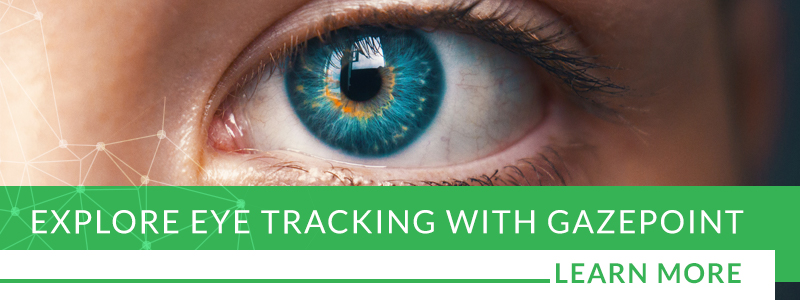
Eye Tracking Applications: Autism Diagnoses
Affordable eye-tracking technology is leading to an increase of its use in many areas, including medical, psychological, and psychiatric research. The equipment is easily accessible, and it offers objective data on human-computer interactions that can lead to great progress in identification and intervention of many disorders. Eye-tracking research has become especially prevalent in research on improved methods for diagnosing autism spectrum disorder.
About Autism Spectrum Disorder
Autism spectrum disorder (ASD) is a neurological variation that occurs in about one percent of the population. It is often diagnosed based on a number of neurological and behavioral markers. Some of those markers include:
- Atypical sensory experiences, such as sensitivity to light, difficulty processing physical sensations, synesthesia, and more
- A need for consistency and routine
- Unusual learning or problem solving abilities, which can be marked by gifted abilities in one area of learning and disabilities in another
- A deep passion or obsession with specific subjects, such as physics, doorknobs, politics, or paper
- Difficulty understanding and/or participating in social interactions, which can be marked by unusual or inappropriate actions or words
- Difficulty understanding and/or using language, both verbal and non-verbal
Parents and pediatricians often recognize the possibility of ASD in a child when that child experiences development delays, such as not speaking for several years.
The Current Diagnosis Process
Early intervention and the implementation of targeted therapy are often cited as being the most effective ways to mitigate the negative impacts of ASD, which is why the diagnosis process for ASD often starts with young children. The current process can be long, elaborate, and expensive, often dependent on subjective factors like parent experiences and a doctor’s opinion.
Developmental Screening
The first step toward diagnosis for many autistic individuals is developmental screening when they are very young. This screening includes a short test or questionnaire to see if the child is learning basic skills at the typical rate of other kids their age. The doctor may talk directly to the child or play with them to gauge how they learn, speak, and move, as well as asking the parents or guardians questions. Developmental delays are often flagged as potential signs of ASD, but the results of a screening alone do not usually qualify as a diagnosis.
Evaluation
 Developmental delays found during a screening may trigger a more comprehensive evaluation. This evaluation can include many different elements, including, but not limited to:
Developmental delays found during a screening may trigger a more comprehensive evaluation. This evaluation can include many different elements, including, but not limited to:
- Interviews of the parents
- Hearing and vision screening
- Genetic testing
- Neurological testing
- Other medical testing
- Clinical interview
- Observation
The family may be referred to a specialist depending on the results of the developmental screening or the evaluation. Doctors often use the tests and methods listed above to compare results with an autism rating scale or guidance in the American Psychiatric Association Diagnostic and Statistical Manual of Mental Disorders, currently in its fifth edition (DSM-5).
Studies on Eye Tracking and Autism
A study done in April 2018 – “Detecting Autism Based on Eye-Tracking Data from Web Searching Tasks” – searched for an alternative method of detecting ASD. Their goal was to explore the possibility of diagnosing ASD through identifying atypical visual-attention patterns. Subjects were tasked with browsing and searching web pages, and the data collected by a Gazepoint eye tracker was used to train a machine learning classifier to distinguish between subjects with autism and a control group without autism.
The results of this particular study were promising for future possibilities. The best performing classifier achieved 0.75 accuracy for identifying autistic individuals via their gaze data. Other studies have found similarly encouraging results.
Research shows that autistic individuals do have different visual patterns — one common symptom of ASD is an avoidance of or apathy toward eye contact. In studies where autistic individuals are presented with different visual stimuli, eye tracking has shown that they prefer looking at geometric patterns rather than human figures or that they focus on a person’s mouth or other features rather than their eyes. A better understanding of these attention and oculomotor patterns could eventually lead to an eye-tracking program with the ability to objectively screen for ASD.
Why Eye Tracking?
There are a number of reasons why eye tracking has become such a focus in the field of ASD research. For one, it can gather data on subjects of all ages, which makes it well-suited for development of a screening process intended for young children.
Non-Invasive
Eye tracking is also non-invasive. The Gazepoint GP3 eye tracker can be attached to or placed near a computer monitor and gather accurate data. In other, past models, eye-tracking equipment often had to be attached to the subject through a method like headgear in order to collect reliable information. A non-invasive solution is especially ideal when studying autistic individuals who may be distracted by such equipment or have sensory processing difficulties that make wearing headgear impossible.
Affordable
One of the greatest advantages of eye tracking – specifically the technology offered by Gazepoint – is that it is high-quality as well as affordable. Gazepoint offers research-grade equipment at a consumer price point to make it accessible to many researchers and medical professionals.
Specific and Customizable
Our software also makes research more effective than ever. You can gather data on specific portions of a visual stimulus by defining areas of interest and you can gauge a subject’s level of interest or cognitive difficulty by measuring their fixations. With this information, you can create a quantifiable measure of a subject’s gaze behavior and visual preferences. This data will be key in future innovations in human-computer interaction studies and eye-tracking-based ASD diagnoses.
Explore the Possibilities With Gazepoint
Whether you plan to continue research into autism and its impact on visual behaviors or you want to discover what you can learn by applying eye tracking to your field of study, Gazepoint has the hardware and software packages you need. Explore our eye-tracking technology bundles, and place your order today.
You can learn more about the applications of eye tracking on our publications page. If you have used Gazepoint technology in your research, please contact our team, and we will make sure to include your study.



